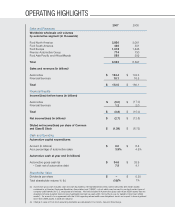Ford 2007 Annual Report Download - page 12
Download and view the complete annual report
Please find page 12 of the 2007 Ford annual report below. You can navigate through the pages in the report by either clicking on the pages listed below, or by using the keyword search tool below to find specific information within the annual report.
Management’s Discussion and Analysis of Financial Condition and Results of Operations
10 Ford Motor Company | 2007 Annual Report
OVERVIEW
Generation of Revenue, Income and Cash
Our Automotive sector's revenue, income, and cash are generated primarily from sales of vehicles to our dealers and
distributors (i.e., our customers). Vehicles we produce generally are subject to firm orders from our customers and are
deemed sold (with the proceeds from such sale recognized in revenue) immediately after they are produced and shipped
or delivered to our customers. This is not the case, however, with respect to vehicles produced for sale to daily rental car
companies that are subject to a guaranteed repurchase option or vehicles produced for use in our own fleet (including
management evaluation vehicles). Vehicles sold to daily rental car companies that are subject to a guaranteed
repurchase option are accounted for as operating leases, with lease revenue and profits recognized over the term of the
lease. When we sell the vehicle at auction, we recognize a gain or loss on the difference, if any, between actual auction
value and the projected auction value. In addition, revenue for finished vehicles we sell to customers or vehicle modifiers
on consignment is not recognized until the vehicle is sold to the ultimate customer. Therefore, except for the impact of the
daily rental units sold subject to a guaranteed repurchase option, those units placed into our own fleet, and those units for
which recognition of revenue is otherwise deferred, wholesale volumes to our customers and revenue from such sales are
closely linked with our production.
Most of the vehicles sold by us to our dealers and distributors are financed at wholesale by Ford Credit. Upon Ford
Credit originating the wholesale receivable related to a dealer's purchase of a vehicle, Ford Credit pays cash to the
relevant legal entity in our Automotive sector in payment of the dealer's obligation for the purchase price of the vehicle.
The dealer then pays the wholesale finance receivable when it sells the vehicle to a retail customer.
Our Financial Services sector's revenue is generated primarily from interest on finance receivables, net of certain
deferred origination costs that are included as a reduction of financing revenue, and such revenue is recognized over the
term of the receivable using the interest method. Also, revenue from operating leases, net of certain deferred origination
costs, is recognized on a straight-line basis over the term of the lease. Income is generated to the extent revenues
exceed expenses, most of which are interest, depreciation and operating expenses.
Transactions between our Automotive and Financial Services sectors occur in the ordinary course of business. For
example, Ford Credit receives interest supplements and other support cost payments from the Automotive sector in
connection with special-rate vehicle financing and leasing programs that we sponsor. Ford Credit records these payments
as revenue, and, for contracts purchased prior to 2008, our Automotive sector made the related cash payments, over the
expected life of the related finance receivable or operating lease. Effective January 1, 2008, to reduce ongoing Automotive
obligations to Ford Credit and to be consistent with general industry practice, we began paying interest supplements and
residual value support to Ford Credit on an upfront, lump-sum basis at the time Ford Credit purchases eligible contracts
from dealers. See Note 1 of the Notes to the Financial Statements for a more detailed discussion of transactions and
payments between our Automotive and Financial Services sectors. The Automotive sector records the estimated costs of
marketing incentives, including dealer and retail customer cash payments (e.g., rebates) and costs of special-rate financing
and leasing programs, as a reduction to revenue. These reductions to revenue are accrued at the later of the date the
related vehicle sales to the dealer are recorded or at the date the incentive program is both approved and communicated.
Key Economic Factors and Trends Affecting the Automotive Industry
Excess Capacity. According to CSM Worldwide, an automotive research firm, in 2007 the estimated automotive
industry global production capacity for light vehicles (about 85.4 million units) exceeded global production by about
16.8 million units. In North America and Europe, the two regions where the majority of revenue and profits are earned in
the industry, excess capacity was an estimated 17% and 11%, respectively. According to production capacity data
projected by CSM Worldwide, significant global excess capacity conditions could continue for several more years at an
average of 18.4 million units per year during the 2008-2014 period.
Pricing Pressure. Excess capacity, coupled with a proliferation of new products being introduced in key segments by
the industry, will keep pressure on manufacturers' ability to increase prices on their products. In addition, the incremental
new U.S. manufacturing capacity of Japanese and Korean manufacturers in recent years has contributed, and is likely to
























